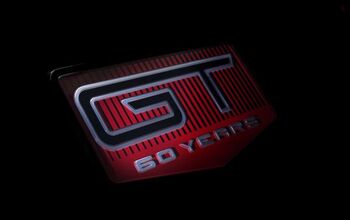End of Days: GM Denies Saab's an Orphan, Chrysler Talks Up "Lifestyle" Pickup
GM has responded to yesterday’s story “revealing” that no one wants to buy the Saab brand. The fact that the denial is off the record [via AFP] tells you that either A) The General is involved in delicate, top-secret negotiation to transfer ownership of the Swedish near-luxury brand to a third party or B) they’re lying. The off-the-record comment from “one GM official familiar with the proceedings” smacks of B: “It’s still early in the process. It’s going to take some time.” Which is the one thing– well one of many things– that GM doesn’t have. Meanwhile, Chrysler is also involved in a smoke and mirrors campaign as part of its ongoing and increasingly incredible effort to convince the world that it’s an ongoing and credible commercial enterprise. Ahead of the don’t call it the Detroit Auto Show, Chrysler product development chief Frank Klegon is talking-up the possibility of building a car-based lifestyle truck. It’s a fiction so boneheaded that even The Detroit News was impolite enough to mention that GM had just abandoned said genre (G8 ST RIP), and that Honda’s Ridgeline is a flop. In fact, scribe Alisa Priddle does a yeoman’s job proving that Klegon is lost in space. “This is a segment where many automakers have recognized there isn’t enough volume for all of the players to invest in their own platform, and there is a lot of sharing going on.” And that’s as good as it gets…
New Corporate Average Fuel Economy (CAFE) standards argue against any such venture.
“Among the proposals for calculating fleet fuel-efficiency in the future is the idea of measuring a vehicle’s ‘footprint’ by multiplying its wheelbase (length of the vehicle as measured between the center of the front and rear wheels) by its track (width as measured between two front or two rear wheels).
“This would force a higher-percentage improvement on small vehicles, [auto analyst Jim] Hall said. If the new standard allows for lower fuel economy for large vehicles, there’s no incentive to do a small one, Hall said.
“‘If footprint stays in there the small trucks are dead,’ Hall said.
“Automakers would have to equip a smaller pickup with such a small engine to meet CAFE that it would lack the power to function as a working truck, Hall said.”
You’d kind of hope ChryCo’s Klegon knows all this. Wouldn’t you?
More by Robert Farago
Latest Car Reviews
Read moreLatest Product Reviews
Read moreRecent Comments
- Jeff JMII--If I did not get my Maverick my next choice was a Santa Cruz. They are different but then they are both compact pickups the only real compact pickups on the market. I am glad to hear that the Santa Cruz will have knobs and buttons on it for 2025 it would be good if they offered a hybrid as well. When I looked at both trucks it was less about brand loyalty and more about price, size, and features. I have owned 2 gm made trucks in the past and liked both but gm does not make a true compact truck and neither does Ram, Toyota, or Nissan. The Maverick was the only Ford product that I wanted. If I wanted a larger truck I would have kept either my 99 S-10 extended cab with a 2.2 I-4 5 speed or my 08 Isuzu I-370 4 x 4 with the 3.7 I-5, tow package, heated leather seats, and other niceties and it road like a luxury vehicle. I believe the demand is there for other manufacturers to make compact pickups. The proposed hybrid Toyota Stout would be a great truck. Subaru has experience making small trucks and they could make a very competitive compact truck and Subaru has a great all wheel drive system. Chevy has a great compact pickup offered in South America called the Montana which gm could be made in North America and offered in the US and Canada. Ram has a great little compact truck offered in South America as well.
- Groza George I don’t care about GM’s anything. They have not had anything of interest or of reasonable quality in a generation and now solely stay on business to provide UAW retirement while they slowly move production to Mexico.
- Arthur Dailey We have a lease coming due in October and no intention of buying the vehicle when the lease is up.Trying to decide on a replacement vehicle our preferences are the Maverick, Subaru Forester and Mazda CX-5 or CX-30.Unfortunately both the Maverick and Subaru are thin on the ground. Would prefer a Maverick with the hybrid, but the wife has 2 'must haves' those being heated seats and blind spot monitoring. That requires a factory order on the Maverick bringing Canadian price in the mid $40k range, and a delivery time of TBD. For the Subaru it looks like we would have to go up 2 trim levels to get those and that also puts it into the mid $40k range.Therefore are contemplating take another 2 or 3 year lease. Hoping that vehicle supply and prices stabilize and purchasing a hybrid or electric when that lease expires. By then we will both be retired, so that vehicle could be a 'forever car'. And an increased 'carbon tax' just kicked in this week in most of Canada. Prices are currently $1.72 per litre. Which according to my rough calculations is approximately $5.00 per gallon in US currency.Any recommendations would be welcomed.
- Eric Wait! They're moving? Mexico??!!
- GrumpyOldMan All modern road vehicles have tachometers in RPM X 1000. I've often wondered if that is a nanny-state regulation to prevent drivers from confusing it with the speedometer. If so, the Ford retro gauges would appear to be illegal.


































Comments
Join the conversation